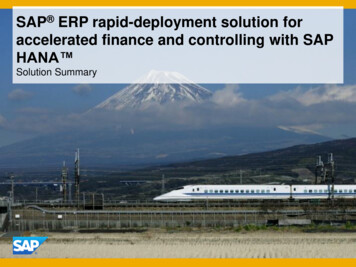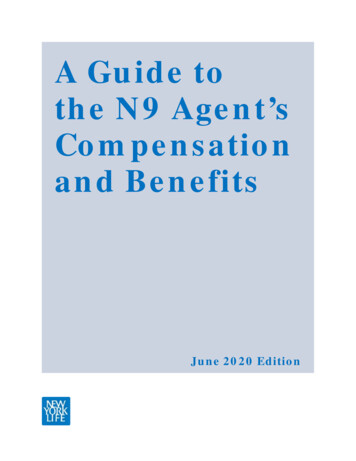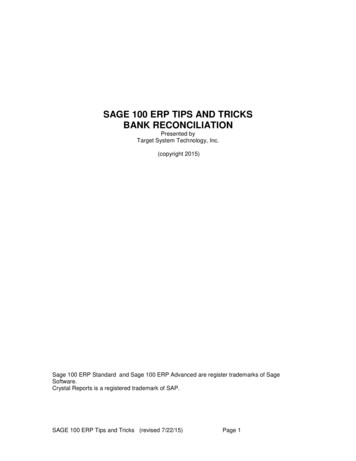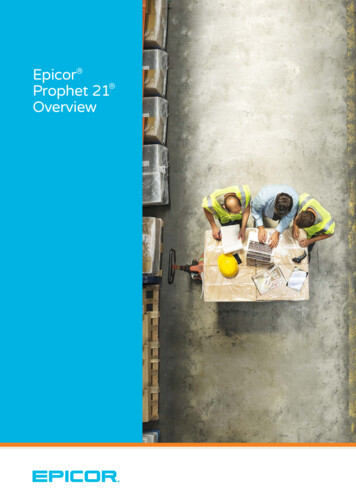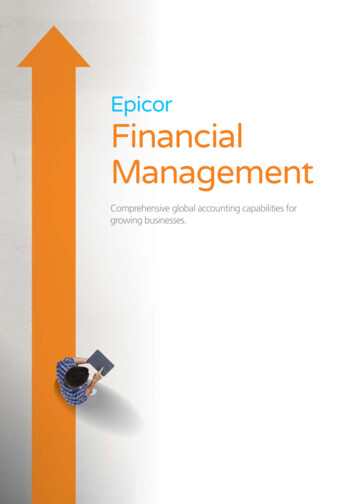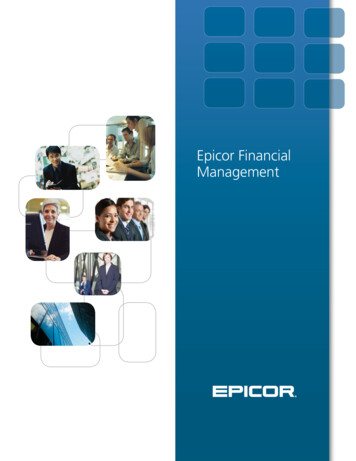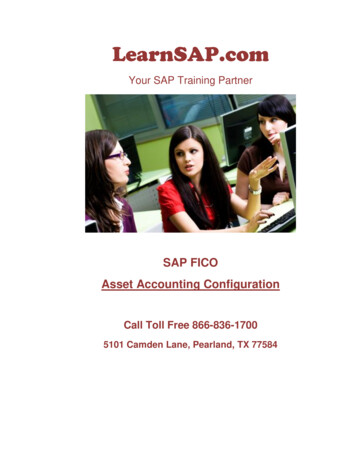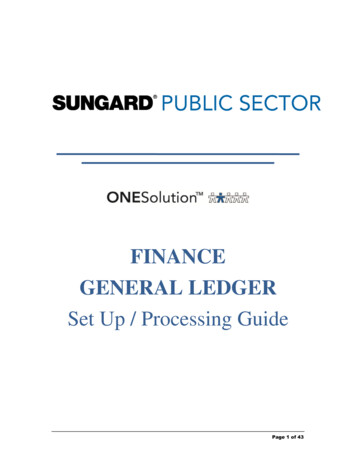
Transcription
FINANCEGENERAL LEDGERSet Up / Processing GuidePage 1 of 43
SUNGARD PUBLIC SECTOR MAKES NO REPRESENTATIONS ORWARRANTIES, ORAL OR WRITTEN, EXPRESS OR IMPLIED, WITH RESPECTTO THE SYSTEM, SERVICES, SOFTWARE, DOCUMENTATION, OPERATINGENVIRONMENT, ANY OTHER SOFTWARE OR SERVICES PROVIDEDHEREUNDER OR ANY OTHER MATTER ADDRESSED HEREUNDER, ANDSUNGARD PUBLIC SECTOR EXPLICITLY DISCLAIMS ALL OTHERWARRANTIES, EXPRESS OR IMPLIED, INCLUDING THE IMPLIEDWARRANTIES OF TITLE, MERCHANTIBILITY AND FITNESS FOR A SPECIFICPURPOSE. Sungard Public Sector shall not be liable for errors contained herein or forincidental or consequential damages in connection with the furnishing, performance oruse of this material. This documentation is proprietary and confidential information ofSungard Public Sector Software Inc. Copying, reproduction or distribution is strictlyprohibited. All rights reserved.Copyright 2009 by Sungard Public Sector, Inc.890 Fortress StreetChico, CA 95973Page 2 of 43
1.Overview – Installation and Implementation Process . 5Accounting Consultation Objectives . 5Sungard Public Sector Training Methods. 5Rollover and Conversion of Existing Data. 5Client Responsibilities. 5Help Desk Procedures .Error! Bookmark not defined.52.General Ledger and Relationship to Other Modules . 62.1 Posting Interfaces – AP, AR, CR, PY, FA, SI. 63.General Ledger Structure. 83.1 Overview of General Ledger Database (GLDB) Structure . 83.2 Define Structural Components . 83.2.1 Tab 1: Organization Key And Parts Definition . 83.2.2 Tab 2: Object And Object Groups Definition. 93.2.3 Tab 3: Account Format and Calendar Definition . 103.2.4 Tab 4: Budget Version Definition. 113.2.5 Tab 5: Presentation Definition . 113.2.6 Tab 6: Miscellaneous Tab. 113.3 Build and Define Organization Keys and Parts. 123.3.1 Create Org Key Parts in GLUPKP. 123.3.2 Create Org Keys in Org Key Definition Form - GLUPKY . 133.3.3 Secondary Key Parts . 133.3.4 Select Codes. 133.3.5 Over Budget Flags . 133.3.6 Valid Object Types . 143.3.7 Misc Codes. 143.3.8 Other features. 143.4 Build and Define Objects and Object Groups . 143.4.1 Create Object Groups in GLUPOG . 153.4.2 Create Objects in GLUPOB. 153.5 Transaction Trapping. 163.6 Optional System Features. 183.6.1 Quick Account Numbers. 183.6.2 Rule Logic for Key Creation. 183.6.3 Default Account Mapping. 184.Budget Overview . 204.1 Direct Budget Update . 204.2 Budget Batch Entry . 204.2.1 Nucleus Common Code for Budget Reason Set-up. 204.2.2 SYNO Common Code for Budget Referencing. 204.3 Budget Models.Error! Bookmark not defined.211.11.21.31.41.5Page 3 of 43
4.4 Budget Item Detail. 204.5 Other sources of budget:. 214.6 Budget Logging . 214.7 Budget Controls. 214.7.1 Blocking versus Warning. 214.7.2 Global Budget Control. 214.7.3 Blocking or Warning by individual Organization key - GLUPKY . 224.7.4 Blocking or Warning by Individual Account Numbers - GLBUUP. 234.7.5 Control Keys -. 245.Set Processing . 275.1 Undo Transactions. 275.2 Journal Entries . 285.2.1 Introduction and Overview of Journal Entries. 285.2.2 Journal Entry - Three Step Process. 285.3 Common Codes . 295.3.1 Other Mask Options. 305.3.2 Recurring Calculation (RC) . 305.3.3 Uses for Recurring Calculations . 306.Subsystem Posting Overview . 316.1.1 How to identify the GL Account . 336.1.2 Org Key Options In Posting Strategies . 336.1.3 Object Code Options in Posting Strategies. 346.1.4 Level (L) . 356.1.5 Type (T) . 366.1.6 Date (D) . 376.1.7 Posting Codes (PCi). 376.1.8 Fund Code (Fund) . 376.2 Accounts Payable . 386.2.1 AP – Open Hold Database . 406.3 Accounts Receivable . 406.3.1 Introduction. 406.4 Pooled Cash Administration. 42Page 4 of 43
1.1.1OVERVIEW – INSTALLATION AND IMPLEMENTATION PROCESSACCOUNTING CONSULTATION OBJECTIVESAchieve a base understanding of the structural components of the General Ledger andhow it relates to the accounting processes of the client. Establish the ONESOLUTIONFINANCE Chart of Accounts structure, and identify the relationship of the GeneralLedger to other ONESolution Finance subsystems. Identify and evaluate third-partyinterfaces, and evaluate the rollover and conversion of client data.1.2SUNGARD PUBLIC SECTOR TRAINING METHODSOn-Site TrainingDistance Learning TrainingIn-house TrainingComputer Based Training1.3ROLLOVER AND CONVERSION OF EXISTING DATATemplates located in Data Conversion GuideConsideration of effort vs. value of information and accuracy of existing data to beconverted.Navaline clients migrating to ONESolution Finance are converted using the standardconversion tool.1.4CLIENT RESPONSIBILITIESAttention to training schedule5
2.2.1GENERAL LEDGER AND RELATIONSHIP TO OTHER MODULESPOSTING INTERFACES – AP, AR, CR, PY, FA, SIThe General Ledger is the primary ledger of the organization. It is essential that theGeneral Ledger control accounts be reconcilable to other subsidiary systems, such asAccounts Payable, Accounts Receivable, Cash Receipts, Payroll, and Fixed Assets. Thedefinition of the relationship between these other systems and the General Ledger is atask that is performed during the initial installation visit where SunGard and the clientinstall the GL and JL Ledgers.Entries are posted to the General Ledger in three levels within the structure: Thedepartment/cost center level, the fund level and the entity level. Generally, thedepartment level has detail transactions posted to revenue and expense accounts, fundlevel has assets, liabilities and fund balance entries which are held for each fund, and theentity level is generally used for storing cash and investment accounts.The relationship of the department level to the fund level is often represented in an "Intrafund" Object Code that is associated with the department level Organization Key and thefund level Organization Key. The relationship of the fund level to the entity level is oftenrepresented by an "Inter-fund" or "Claim on Cash" Object Code which is associated withthe fund level Organization Key and the entity level Organization Key.Interfaces between other systems and the General Ledger are given by defining, for eachtype of transaction, which entries are to occur automatically at these three different levelsof accounts. This allows all entries to asset, liability (and even fund balance) accounts tobe made automatically by the software.6
Figure 1: Subsystems Overview7
3.3.1GENERAL LEDGER STRUCTUREOVERVIEW OF GENERAL LEDGER DATABASE (GLDB) STRUCTUREThe General Ledger database is made up of two sides, the General Ledger (GL) side andthe Job Ledger (JL) side. Both sides of the GLDB have Account Structures that are madeup of Organization Keys, Key Parts, Object Codes, and Object Groups. The primarydifference is that the JL does not “stand alone” and does not have it’s own postingstrategies with the other ONESolution Finance subsystems. Each defined JL must beattached to a particular GL. The system allows multiple General Ledgers and allows asmany as ten Job Ledgers attached to each GL.Also housed in the GLDB is the Budget. Each defined General Ledger and Job Ledgercontains as many as 25 budget versions available for use.The Job Ledger is used in ONESOLUTION FINANCE as a means to maintain a cleanGeneral Ledger yet maintain detail transactional detail for departmental informationneeds.3.2DEFINE STRUCTURAL COMPONENTSAccessed through General Ledger (GL) Update (UP) General Information (GN) MASK:GLUPGNThis mask accesses the General Ledger core information table. The ‘GLG GEN MSTR’table to be precise. All the foundation of the GL and JL are defined here. The‘GLG GEN MSTR’ has six input tabs to set up. Generally, once ‘GLG GEN MSTR’is fully defined, and fully operational, it is rarely changed. Your GL Consultant willguide you in the proper settings for your particular business practices.3.2.1Tab 1: Organization Key And Parts DefinitionFigure 2: GLUPGN - Org Key (1)On this screen the accountant defines how many characters or digits the Org. Key willtake, the ‘name’ of the Org. Key and whether or not all Org. Keys will be comprised ofthe same number of digits or characters.8
Figure 3: GLUPGN - Org Key (2)The accountant will also define the required Org. Parts and the optional Select Codes thatmay be used to further define the Org. Key.Note: Each Part Short CODE is automatically case up-shifted.The Part Codes assigned values will be defined on the General Ledger Update KeyInformation (GLUPKY) screen. Each defined Organization Key must have a validatedpart value for each Part defined. The value may sometimes be Not-Applicable. Forexample, an Organization Key that denotes a Fund Balance Sheet key would not need aManagement Location coded value other than Not Applicable.The Select Code Description is a validated coded value and is defined in NucleusCommon Codes Category GLS1 through GLS8. Select Codes are not required.3.2.2Tab 2: Object And Object Groups DefinitionFigure 4: GLUPGN - Object (1)9
Figure 5: GLUPGN - Object (2)The object code structure is used to establish groupings of line items for reportingpurposes, report sorting, and budget checking. Balance Sheet and Income Statementradials affect standard reports only. That Valid Subsystem Headings are representativeof the Subsystems that are installed on your system.3.2.3Tab 3: Account Format and Calendar DefinitionFigure 6: GLUPGN - CalendarAny transactional data entries into ONESOLUTION FINANCE are date driven. Thecalendar definition set-up is the framework to define periods and is based on theorganization’s fiscal year. Period 13 can be designated as closing period.10
3.2.4Tab 4: Budget Version DefinitionFigure 7: GLUPGN - BudgetThere are 25 budget versions available for use. See on-line help for specifics.3.2.5Tab 5: Presentation DefinitionFigure 8: GLUPGN - PresentationThe account heading is user defined as well as data entry input and report formats. Seeon-line help for specifics.3.2.6Tab 6: Miscellaneous TabFigure 9: GLUPGN - Miscellaneous11
The Miscellaneous screen controls accumulators. If you change an accumulator selectionyou will need to re-compute accumulators for it to take effect.See on-line help for details.3.3BUILD AND DEFINE ORGANIZATION KEYS AND PARTSThe Organization Key is the area of the General Ledger that defines the administrativelevel or Cost Center level for accounting purposes. The “Where and Why” theorganizational area within the organization exists for accounting purposes. It couldrepresent a Fund Administration Key, the Accounting Department, or a specific grant orprogram.The Organization Part Definition that was defined on GLUPGN tab1 (Figure 2:GLUPGN - Org Key (1)) is further defined by building lists of values for the Parts andSelect Codes. The Parts are entered into the ‘GLK GRP MSTR’ table. These Org. Partsare then used to ‘build’ the Org. Key attributes in the ‘GLK KEY MSTR’ table, usingGLUPKY.The GLUPKY mask accesses the Org. Key Definition form as well as the Org. Key PartDefinition form. To access the Org. Key Part Definition form go to Options and Link tothe Organization Part Screen (Figure 4: GLUPGN - Object (1)).It is important for the user to understand the concepts of filling tables with these valuesfrom these forms. This is how the user will add, and edit a variety of information andprocessing details of specific keys. There is a General Ledger utility available to uploadthis information from spreadsheets, which are available on ONESOLUTION FINANCEInsider.3.3.1Create Org Key Parts in GLUPKPBefore any key can be set up, all required key parts must be set up in GLUPKP.Typically this will be a list of all funds, functions, departments, etc – any site specificgroup needed to report on and also groups needed for financial reporting.Figure 10: GLUPKP12
3.3.2Create Org Keys in Org Key Definition Form - GLUPKYAfter key parts are defined, Org Keys can be added into GLUPKY. There are threedifferent levels of Org Keys: the cost center level org key which typically represents adepartment where expenditure and sometimes revenue are recorded; the Fund Key Levelwhich represents a Fund account where Balance Sheet items are recorded and revenues ifthey are not specific to any department.The third level is the Entity level. Clients who use pooled cash will set up a pooled cashOrg Key at Entity level where Cash and Investments are held.Figure 11: GLUPKYThis is an example of a defined Cost Center Key.3.3.3Secondary Key PartsSecondary key parts are an extension to the primary key parts discussed earlier.Secondary key parts do not have to be required and validated.3.3.4Select CodesNote that there are Select Codes defined for this key. Select Codes are optional and areset-up in Nucleus Common Codes. The select code values are verified against theCommon Code when entered here. The descriptions of the Select Codes were set onGLUPGN Screen 1.3.3.5Over Budget FlagsPlacing Action Codes at different object group levels controls how budgeting iscontrolled for this specific area of the organization.A Control Key may also be established.13
3.3.6Valid Object TypesThe key can be set to be valid with only specific Object Types if desired. Up to 6 can bedefined here. If left blank all object types are valid. The seven object types are: AS,Asset; LI, Liability; FB, Fund Balance; RV, Revenue; XP, Expense; TI, Transfer In; TO,Transfer Out.Each of the values that are entered in the ORG. PART CODES section of this form mustbe pre-defined on the Org. Part Definition Form. The code descriptions are echoed.3.3.7Misc CodesThese fields are not verified against an existing table, but can be used in a variety of waysto tag keys with additional information. For example the abbreviation of INT or NOINTmay indicate this keys participation in the Investment Pool Interest, or a number may beused to indicate square footage for overhead allocations in Recurrent Journal entries. TheMISC codes can also be used to store account numbers for use in Recurrent Journalentries.3.3.8Other featuresCopy Key; used to Copy the Associations established for other keys when using theAssociation feature, and Require JL; a Y in this field requires a Job Ledger account atdata entry time when using this key.Require Association: Control Objects use Organization Keys by associating themthrough transactions or entering budgets.Require Job Ledger: Require that when this object is used a JL Account must beentered.Allow Subsystems:3.4Control which subsystems may have transactions with the Object.BUILD AND DEFINE OBJECTS AND OBJECT GROUPSThe Object Code is the area of the General Ledger that defines the familiar line item foraccounting purposes and budgeting. ‘What’ are the classifications of the money beingreceived or spent in the organization? If the organization consiste
PURPOSE. Sungard Public Sector shall not be liable for errors contained herein or for incidental or consequential damages in connection with the furnishing, performance or use of this material. This documentation is proprietary and confidential information of Sungard Public Sector Software

